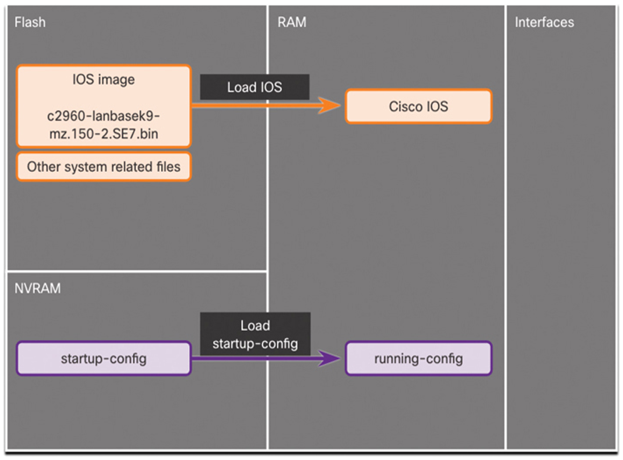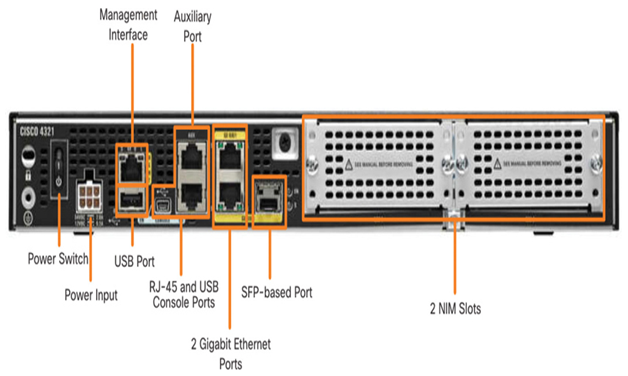As shown in Figure 35-16, a Cisco device loads the following two files into RAM when it is booted:
• IOS image file—The IOS facilitates the basic operation of the device’s hardware components. The IOS image file is stored in flash memory.
• Startup configuration file—The startup configuration file contains commands that are used to initially configure a router and switch and create the running configuration file stored in RAM. The startup configuration file is stored in NVRAM. All configuration changes are stored in the running configuration file and are implemented immediately by the IOS.

Figure 35-16 Memory Location of IOS and Startup Configuration
The running configuration file is modified when the network administrator performs device configuration. When changes are made to the running-config file, it should be saved to NVRAM as the startup configuration file in case the router is restarted or loses power.
Video—Establish a Console Connection (35.3.5)
Refer to the online course to view this video.
A router is a computer with specialized hardware and a network operating system. A computer, such as a PC running Linux, could even be configured as a router for a small network. Cisco routers have specialized hardware and software designed to provide the features and performance needed for enterprise and service provider networks.
Video—Cisco Router Components (35.4.1)
Refer to the online course to view this video.
Regardless of their function, size, or complexity, all router models are essentially computers. Just like computers, tablets, and smart devices, routers also require the following:
• Operating system (OS)
• Central processing unit (CPU)
• Random-access memory (RAM)
• Read-only memory (ROM)
• Nonvolatile random-access memory (NVRAM)
Like all computers, tablets, and smart devices, Cisco routers require a CPU to execute OS instructions, such as system initialization, routing functions, and switching functions.
The CPU requires an OS to provide routing and switching functions. The Cisco Internetwork Operating System (IOS) is the system software used for most Cisco devices, regardless of the size and type of the device. It is used for routers, LAN switches, small wireless access points, large routers with dozens of interfaces, and many other devices.
Router Interface Ports (35.4.3)
Although there are several different types and models of routers, every Cisco router has the same general hardware components.
Figure 35-17 shows a Cisco 4321 Integrated Services Router (ISR).

Figure 35-17 Connections on the Cisco 4321 ISR
The router includes the following connections:
• Console ports—Two console ports for the initial configuration and command-line interface (CLI) management access using a regular RJ-45 port and a USB Type-B (mini-B USB) connector.
• Two LAN interfaces—Two Gigabit Ethernet interfaces for LAN access labeled GE 0/0/0 and GE 0/0/1. The GE 0/0/0 port can be accessed through an RJ-45 connection or by using a small form-factor pluggable (SFP) attachment to provide a fiber-optic connection.
• Network Interface Modules (NIMs)—Two NIM expansion slots that provide modularity and flexibility by enabling the router to support different types of interface modules, including serial, digital subscriber line (DSL), switch ports, and wireless.
The Cisco 4321 ISR also has a USB port, a management interface, and an auxiliary port. The USB port can be used for file transfers. The management port can be used for remote management access when the two Gigabit Ethernet interfaces are unavailable. The auxiliary port provides legacy support for a method for connecting a dial-up modem to the router for remote access. The auxiliary port is rarely used in networks today.
